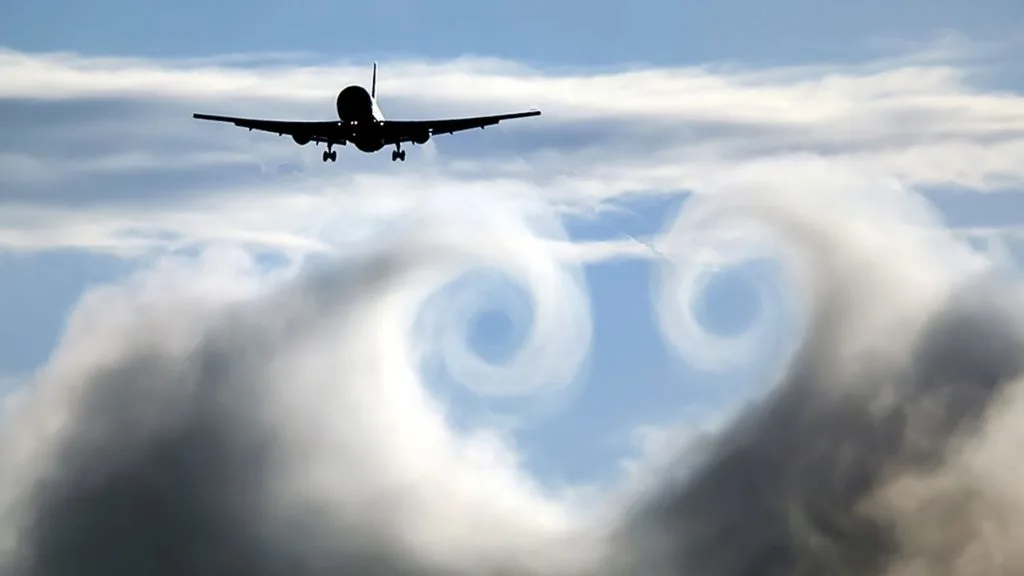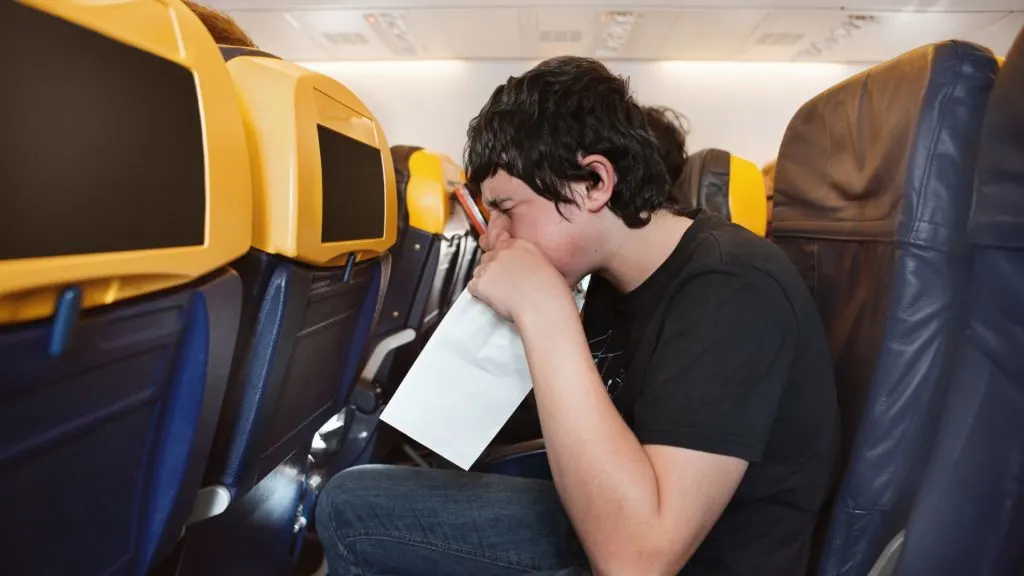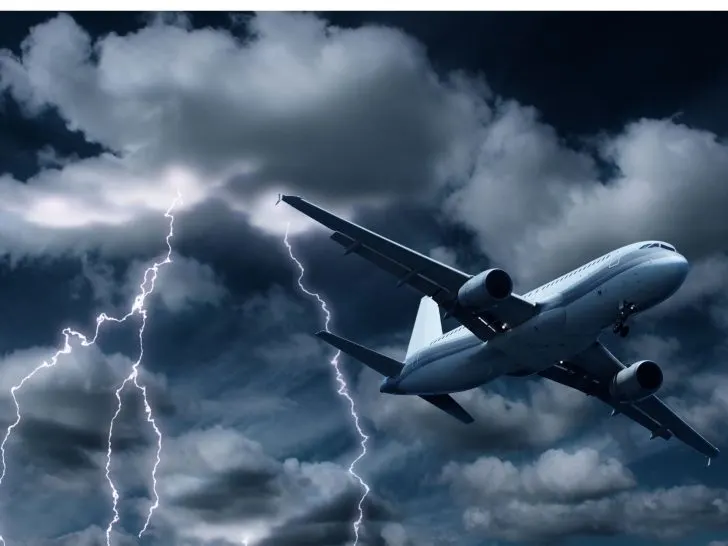Nervous flyers are on edge throughout the entire flight. If the plane hits some rough air that can send your anxiety through the roof. So you might be wondering, can turbulence crash a plane?
My family was recently on a flight that even had me questioning if turbulence could send us crashing down. A few minutes of turbulence is one thing, but four straight hours of non-stop shaking is rough.
My stressful flight is what caused me to come home and find out everything there is to know about turbulence. Luckily we all landed safely although a bit nauseous as we started our vacation.
Find out every kind of turbulence and if there is any cause for concern.
Jump to:
Understanding Turbulence
When you fly, experiencing turbulence is a common occurrence. Light turbulence might shake your drink, while moderate turbulence has a more pronounced jostling effect. Severe and extreme turbulence can be unsettling and potentially hazardous, yet incidents causing injuries are uncommon.
Turbulence is the chaotic, irregular air movement that pilots and passengers often encounter. It’s driven by various atmospheric conditions, including wind shear, jet streams, and mountain waves. Thermal turbulence happens due to hot rising air, while mechanical turbulence is caused by natural obstructions like mountains disrupting air flow.
Clear-air turbulence (CAT) is particularly sneaky as it can occur in clear skies without visual cues, like clouds, to warn pilots and passengers. Wake turbulence is created by another aircraft in flight, and frontal turbulence occurs when two different air masses collide. Remember, despite the discomfort, only rarely can turbulence crash a plane. Your flight crew is well-trained to handle these bumpy patches for your safety.

Turbulence and Aviation Safety
You might wonder, can turbulence crash a plane? In the realm of air travel, encountering turbulence is a common occurrence. Turbulence refers to the unstable air movement that can vary from mild to severe, and it’s important for flight safety that you understand its implications.
Safety Protocols
- Seat Belts: Always listen to your flight crew and keep your seat belt fastened when seated.
- Cabin Procedures: Crew members secure the cabin to prevent injuries from unsecured objects.
Understanding Risks
- Severity: Turbulence can cause minor to serious injuries if passengers and cabin crew are not properly secured.
- Rare Extreme Cases: There are very rare instances of severe turbulence possibly contributing to plane crashes, but modern aircraft are designed to withstand it.
Mitigation Measures
- Flight Crew Training: Pilots and cabin crew are trained to handle turbulence and ensure your safety.
- FAA Regulations: The Federal Aviation Administration (FAA) sets safety standards which include procedures for navigating through turbulent air.
- Technological Aids: Air traffic controllers use advanced technology to predict and avoid turbulence whenever possible.
Your safety on commercial flights is the primary concern for airlines and the entire flight crew. Rest assured that with rigorous safety measures in place and the professional vigilance of your pilots and flight attendants, you’re in safe hands even when those unexpected bumpy moments arise.
Aircraft Response to Turbulence
Aircraft Design and Structural Integrity
- Built to Withstand: Modern airplanes are constructed with safety as the primary focus, especially regarding turbulence. Key components, like the wing spar, are engineered to be extremely robust. During certification, these parts must endure forces up to 1.5 times greater than those experienced under normal flight conditions, ensuring they can handle unexpected severe turbulence without structural damage.
- Aircraft Flexibility: The flexibility of an aircraft’s wings and body is a critical aspect of its design, allowing it to absorb and adapt to pressures from turbulent air. This reduces the risk of mechanical failure and ensures the aircraft can safely navigate through rough air.
- Safety Features: Innovations in aircraft design, such as enhanced structural materials and advanced aerodynamics, contribute to the airplane’s ability to endure various kinds of turbulence. These features help prevent minor injuries and minor damage even when encountering abrupt changes in atmospheric pressure or strong winds.

Pilot Training and In-Flight Strategies
- Turbulence Penetration Speed: This is a crucial concept in aviation. It refers to a reduced speed that helps maintain the aircraft’s structural integrity and control during turbulence. By flying at this speed, pilots ensure the plane remains within safe operational limits.
- Navigational Adjustments: Commercial airline pilots are trained to adjust the flight path based on real-time weather updates and air traffic control information. This might involve changing altitude to find smoother air at higher or lower altitudes or rerouting around a mountain range or severe weather conditions to avoid severe turbulence.
- Communication and Crew Coordination: Pilots and cabin crew work closely to manage and communicate about turbulence. This coordination ensures that everyone on board is prepared and secured, minimizing the chance of turbulence-related incidents.
Technology and Tools Used in Modern Aviation
- Weather Forecasting and Sensors: Advanced technology gives pilots real-time data. They monitor weather conditions, wind flow, and types of turbulence. Radar and satellites detect clear air turbulence. This turbulence has no visible clouds, making it hard to predict and avoid.
- Air Traffic Control Support: Pilots communicate continuously with air traffic controllers. They receive updates on weather patterns. This includes cold fronts, thunderstorms, and high wind speeds. Controllers also relay reports from other aircraft about turbulence levels.
- Automated Systems: Many modern planes have automated systems. These systems manage the plane’s response to air pockets or vertical currents. They help the pilot make quick adjustments to flight controls. This maintains stability and keeps the plane on course.
Understanding the Rarity of Turbulence-Related Accidents
- Statistical Perspective: Patrick Smith, a seasoned commercial airline pilot and author, notes that turbulence-related accidents are extremely rare. While turbulence can be unsettling, the aviation industry’s standards and practices have made it a minor safety issue relative to other risks such as pilot error or human error.
- Historical Data: Incidents where turbulence led to serious consequences, such as the American Airlines or Lufthansa flights experiencing sudden altitude changes, are extensively studied. These studies have helped improve training and technology, further reducing the chances of such events recurring.
By understanding how modern aircraft are designed, how pilots are prepared to handle turbulence, and the technology that supports them, passengers can feel more secure when experiencing airplane turbulence. This knowledge can transform anxiety into appreciation for the sophistication and safety of modern air travel.
Myths and Misconceptions
Flying can sometimes feel like a leap into the unknown, especially when turbulence hits. Misconceptions can fuel fear, but let’s set the record straight with some common myths and the realities of airplane turbulence:

Can Turbulence Crash a Plane?
- Reality: Modern airplanes are feats of engineering designed to withstand much more than the everyday stresses of flight, including high levels of turbulence. These aircraft undergo rigorous testing, including stress tests that simulate both “minor damage” and “severe structural damage” scenarios, ensuring they can handle unexpected “erratic changes” in atmospheric pressure without falling apart.
Every Bout of Turbulence Signals Dangerous Weather Ahead
- Reality: While it’s easy to think that turbulence is a harbinger of a storm, it’s often just the plane moving through different “weather patterns” or “wind flows”. Turbulence can be caused by a variety of factors such as “warm air rises”, “cold fronts”, or even “mountain ridges” disrupting air flow. Not every turbulence encounter means there’s bad weather on the horizon.
A Plane’s Wings Will Snap Off in Severe Turbulence
- Reality: Aircraft wings are designed to be incredibly flexible. They can bend significantly to absorb the forces of even “severe turbulence” without risk of snapping. The design and materials allow for what might look like alarming flexing but are actually safety features in action, critical in maintaining the plane’s ability to navigate through “rough air” at “higher altitudes”.
Understanding the Causes of Turbulence
Turbulence is usually caused by the complex interplay of air movements, including “vertical currents”, “wind direction changes”, and the collision of different “air masses” near “mountain ranges” or “hilly terrain”. “Clear air turbulence” (CAT), a type that occurs without visual cues like clouds, is particularly challenging to predict and is often encountered near “jet streams” or over “high altitudes”.

The Reality of Turbulence-Related Risks
Turbulence is a common concern but seldom a serious threat to modern aviation. Incidents like the “American Airlines flight” or the “Lufthansa flight” are thoroughly analyzed. Such “turbulence accidents” are rare. The aviation industry has evolved. Now, “commercial airlines” and “small aircraft” easily access technologies and training. These enhance safety amid unexpected air movements.
Next time turbulence shakes your flight, remember it’s normal. It doesn’t signal danger. Modern aircraft use advanced “aircraft design” technologies and “flight plan” strategies. They safely handle even “extreme turbulence”. Feel that familiar bumpiness? Take a deep breath. Trust the robust “aviation industry” standards. You’re in good hands. Your flight is equipped to make your journey smooth and safe, even through a bit of “mountain wave” turbulence.
Managing Fear and Ensuring Comfort
When you’re flying, the thought “can turbulence crash a plane” may cross your mind, but it’s important to know that planes are designed to endure turbulence. Staying informed is the best way to ease these concerns. Understanding the facts about what causes turbulence helps demystify the experience and quell your fears.
Flight hacks before a trip:
- Learn: Knowing that turbulence is a normal, well-handled part of flying can alleviate much of your worry.
- Seat Selection: Pick a seat over the wings where the ride tends to be smoother.
- Planning: Schedule flights for early morning or late evening when turbulence is less common due to cooler air temperatures.

During Turbulence:
- Deep Breathing: Practice breathing exercises to keep calm.
- Distraction: Listen to music, watch a movie or engage in reading to take your mind off the situation.
- Trust: Have confidence in the crew who are trained to handle these situations.
Helpful Reminders for Your Comfort:
| Tips | Action |
|---|---|
| Stay Seated | Keep your seatbelt fastened whenever seated. |
| Mindfulness | Use meditation techniques to remain present and calm. |
| Hydration | Drink water to stay hydrated and feel better overall. |
Remember, the crew is your ally. They can answer questions and provide reassurance. Next time you experience turbulence, these tips can make your journey more comfortable and less intimidating.



Leave a comment